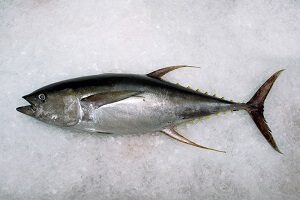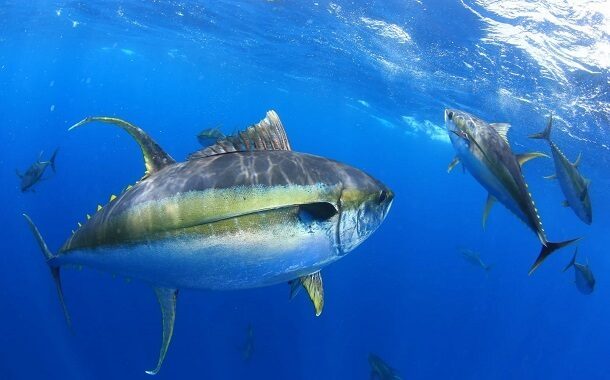What is The Yellowfin Tuna Price per Pound?
Last Updated on December 29, 2023
Written by CPA Alec Pow | Content Reviewed by ![]() CFA Alexander Popinker
CFA Alexander Popinker
Although often marketed as Ahi tuna, the Yellowfin tuna is a subspecies of the Ahi and is a fish that can reach weights of 400 pounds. It is usually found in tropical and subtropical oceans.
This fish is one of the best sources of minerals, vitamins, and protein, and like many other types of fish, is full of Omega-3 oil.
The second dorsal find and the anal fin of the Yellowfin are the reason for its name, as they are colored in bright yellow. So what is the yellowfin tuna price?
How much does yellowfin tuna cost per pound?
The price of yellowfin tuna is somewhere between $9 and $16 per pound if the yellowfin is not sushi quality and you get it from local fishermen. Its cost will also be influenced by other factors, like its grate, where you live, and where it is caught.
You will also find the best sushi-grade yellowfin tuna for an average price per pound of $35 on retail websites like Amazon.com, and this price won’t include shipping expenses.
Yellowfin tuna price – additional costs
There are a lot of reputable online shops that offer overnight shipping on fish and shellfish. Be careful, though – as long as you don’t meet the minimum spending requirement per order, you will most likely be charged shipping fees which are typically around $15 to $25 or more depending on the retailer’s billing policy.
Yellowfin tuna details
Yellowfin tuna is a versatile fish and it will usually be packaged either frozen, fresh, or in cans. It can also be sold as steaks, in portions, loins, or chunks. When you get it fresh from the market, it will usually be sold in filets of one to three pounds in weight. It should come with a packaging label that shows an expiration date, as well as the exact date when the fish has been caught.
Depending on the type of fresh yellowfin you’re trying to get, there are two grades you can pick from: sashimi and other. When it comes to the “other” category, you will have to be very careful not only when you cook it but also when you eat it, as it is sometimes questionable and unsafe.
You might also like our articles about the cost of Mahi Mahi, escargot, or shrimp.
The fish is usually sold in loin form, unlike Canned tuna fish. It has a mild flavor with dense meat similar to beef and the texture of your average steak. You will usually find it in the meat department.
Important things to consider
 If you want to buy the perfect yellowfin tune, you should look for cuts that are free of fat and trimmed neatly. It should have no tales or bones and it should be firm. Its color should be a darker shade of red.
If you want to buy the perfect yellowfin tune, you should look for cuts that are free of fat and trimmed neatly. It should have no tales or bones and it should be firm. Its color should be a darker shade of red.
If you aren’t sure that the website you’re purchasing from is the real deal, then purchasing online is pretty risky. This is why, before ordering online, you should make sure that the store you’re placing an order with not only has a good reputation but also has a strict policy of offering refunds to customers with no hassle if they don’t like the products they receive.
According to an FDA recommendation, you shouldn’t consume more than six ounces of mercury-ridden fish per week. You should also avoid yellowfin tuna completely if you fall in the category of either the elderly, pregnant women, children, or people at risk, as this fish might be unsafe for you in this case.
A lot of people consume seafood during Summertime, and this is one of the favorite types of fish for people. It will have a great taste regardless of whether you’ll enjoy it smoked, pan-seared, broiled, or grilled. You can even eat it raw with dipping sauce as long as it is fresh.
To keep the loins fresh as much as possible, keep them in your freezer, in the coldest section.
Although it is available all throughout the year, this fish will peak between April and September.
You will know you’re looking at a Yellowfin tuna if it has silverfish scales on a dark metallic body with blue accents. The fins should also be bright yellow.
The number one quality usually comes from Japan and is the type used for sushi/sashimi, while the number 2 quality is sold in retail and restaurants and is adequate for the US market.
The biggest yellowfin tuna world record was set by a massive fish with a weight of 427 pounds that was caught in 2012.
The texture of the skin, even when cooked, isn’t an enjoyable one, so you should remove it before serving and eating the fish, according to MarxFoods.
Yellowfin tuna vs Bluefin tuna
The main difference is the size, but they also have different flavors and tastes. Yellowfin tuna species has less fat content than Atlantic Bluefin Tuna which causes it to lack a strong “tuna” flavor. The yellowfin tuna is considerably smaller than the bluefin one.
Yellowfin tuna’s fat content can be more noticeable when you pay attention to the filets. Due to this, Bluefin pieces tend to command a higher price tag because they are leaner and healthier for consumption than their cheaper counterpart.
The appearance of bluefin and yellowfin tuna is also different. As explained by OnTheWater, the pectoral fin on a yellowfin reaches beyond the beginning of their second dorsal fin which is typically only about 40% as long. The tail fins are also quite distinct – with bluefins having darker blues colors for both their first and second dorsal fins while yellows will have more grays in them.
Spending less and fish market prices
Fish markets usually have better tuna prices than your local grocery store.
If buying from any retailer or fish market, special sales are often a great time to stock up on fresh tuna yellow fin fish. If you find the right deal, don’t be afraid of stocking your freezer with tunafish because it freezes well.


Leave a Reply
Want to join the discussion?Feel free to contribute!